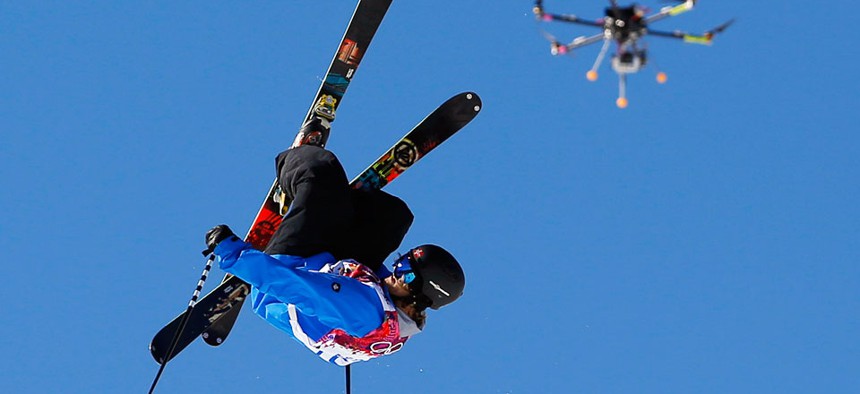The Best Cameramen at the Olympics Are Drones

A drone camera follows Norway's Aleksander Aurdal during the men's ski slopestyle final at the 2014 Winter Olympics. Sergei Grits/AP
The use of unmanned aerial vehicles for sports photography is far from a passing gimmick.
Drones are being used to film ski and snowboarding events at the Winter Olympics in Sochi, as you may have noticed. But the use of unmanned aerial vehicles for sports photography is far from a passing gimmick. In fact, you should expect more and more athletic events to be filmed by drone.
Remo Masina isn’t involved in shooting the Olympics, but he’s already familiar with drones’ finesse for filming winter sports: He uses them to film skiers for commercials. The drones are quieter and cheaper than a manned helicopter (though they can still cost up to $40,000), he told the Associated Press, and they allow the filmmaker to get much closer to his subject.
Drones are also more flexible than cable-suspended camera systems, which are also present at the Winter Olympics. While live transmission is tricky—it requires an extra transmitter, which weighs on the drone—Masina says he’s flown such devices at over 40 mph while delivering live, high-definition video.
Masina says that drones are “for sure” the future of sports broadcasting. UK company HeliPOV, which provides drones on which to mount existing cameras, has some great examples of just how cool the resulting video can be:
It won’t take long for drones to be fully integrated into sports broadcasting: One company is already prototyping drones that automatically follow an athlete from a few feet away—perfect, they say, for downhill skiing. And drones are also making appearances at events smaller than the Olympics.
There are limitations: In many countries, drone regulations are still lagging behind the times, and it might not be clear to a broadcaster that they can be used legally. Then there are concerns about crashes. But with the risks low and potential benefits high, it could be that sports photography will be one of the first uses of drones to go mainstream.
Reprinted with permission from Quartz. The original story can be found here.





